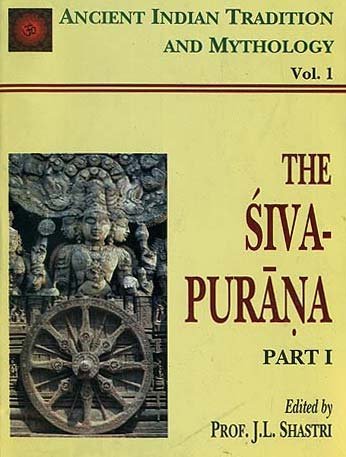Shiva Purana
by J. L. Shastri | 1950 | 616,585 words
This page relates “creation and sustenance” as found in the Shiva-purana, which, in Hinduism, represents one of the eighteen Mahapuranas. This work eulogizes Lord Shiva as the supreme deity, besides topics such as cosmology and philosophy. It is written in Sanskrit and claims to be a redaction of an original text consisting of 100,000 metrical verses.
Disclaimer: These are translations of Sanskrit texts and are not necessarily approved by everyone associated with the traditions connected to these texts. Consult the source and original scripture in case of doubt.
Chapter 9 - The creation and sustenance
[Sanskrit text for this chapter is available]
The sages said:—
1. How does lord Śiva perform his great sport commanding all, creating the universe and placing it in position?
2. What is it that came into being at the outset? By what are all these pervaded? By which being of huge belly is this swallowed?
Vāyu said:—
3. Śakti came into being at the outset; with Śāntyatītapadā following. From Śiva in association with Śakti Māyā came into being and then the unmanifest from it.
4. Śāntyatītapada originated from Śakti and from it Śāntipada; then the Vidyāpada; from it the Pratiṣṭhāpada came into being.
5. Nivṛttipada originated from Pratiṣṭhāpada. Thus has been briefly described the creation induced by the lord.
6. The creation of these is in the inverse order; the annihilation is in the reverse order. There is a creator apart from and greater than what is indicated by these five Padas.
7. Hence the entire universe is pervaded by the five Kalās. Avyakta is the cause there but activitised by the Ātman.
8-10. It is agreed that everything begins with intellect and ends with Viśeṣa but the makership is neither of the Avyakta nor of the Puruṣa since Prakṛti is insentient and Puruṣa ignorant. Without an intelligent cause nothing is created by the insentient beings—Pradhāna, Paramāṇu etc. But the universe is dependent on a maker since it is an effect composed of parts.
11-12. Hence the creator must be powerful, independent, omnipotent and omniscient with no beginning, no end and endowed with lordly qualities. He is the maker of the universe, Mahādeva, Maheśvara, the protector and annihilator of everything. He is separate from it.
13. The transformation of Pradhāna and the activities of the Puruṣa function at the bidding of the lord of truthful vow.
14. It is in the minds of the noble that this firm and permanent conviction finds a place. A being of meagre consciousness does not' resort to this side.
15-17. Hundred Brahmā years constitute the span of Brahmā born of unmanifest It is termed Para. Its half is Parārdha. At the advent of Dissolution the Avyakta withdraws to itself all its effects and abides in Ātman.
18. When the Avyakta abides in Ātman, when the effects have been withdrawn, Pradhana and Puruṣa stand on an equal footing.
19. The two have the Guṇas of Tamas and Sattva, remaining on a par with each other. The two without the Guṇas being predominant are mutually interwoven.
20. In the equal and undivided state of Guṇas in the rise of darkness, when the wind was in full[?] and the water was calm, there was nothing to be seen.
21-22. When the universe was unmanifest the lord meditated upon the great Śakti throughout the night. When it dawned the lord in contact with Māya entered Pradhāna and Puruṣa and set them to motion.
23. Then at the bidding of Brahmā, the creation evolved out of the unmanifest that is the source of origin and the spot of merger for all living creatures.
24. Obeisance to him who is different from the worlds, in a fraction of whose Śakti everything terminates, whose will is ever variegated and wonderful far above that of the universe and whom those who know the path call the lord of the path—the Ātman.
